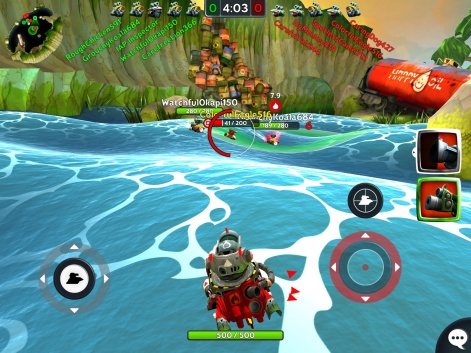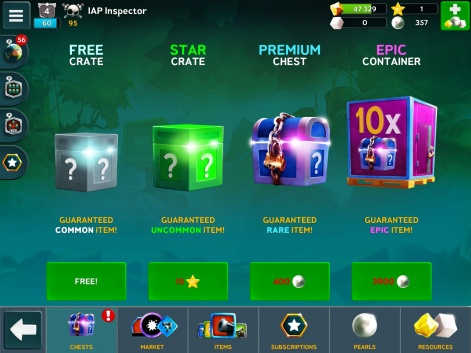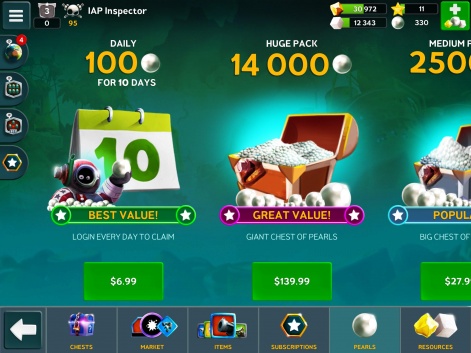Welcome back to the In-App Purchase Inspector - our regular look at free-to-play games from the consumer's perspective.
In each instalment, we consider the incentives or pressure applied to make in-app purchases, their perceived value, the expansion offered by IAPs and the overall value of the experience.
The end goal is to see whether the game makes a good enough case for us to part with our cash, or whether players are content - or engaged enough - to 'freeload'.
This time, we're taking a look at Battle Bay, a real-time five-on-five multiplayer effort from Angry Birds developer Rovio that's finally emerged after more than a year in soft launch.
Setting sail
When Battle Bay was soft-launched in selected territories back in March 2016, it was surprising to see Rovio taking a punt on something so different to the Angry Birds series with which it made its name.
A far cry from flinging feathered mascots at pigs, this is a five-versus-five arena battler in which players deck out boats with weapons and do battle in them.

Perhaps more suprising is the fact that Battle Bay has made it to global launch at all, given that Rovio's spate of recent soft launches has resulted in very few worldwide releases.
But while this is definitely new territory for Rovio, it's easy to see why they've shown such faith in it. Visually beautiful and slick in all departments, Battle Bay has no doubt benefited from Rovio's wealth of talent and resources.
Battle Bay is targeting a very different kind of player than the casual Angry Birds fan.
It's a game with great potential to monetise well, loosely in the same category as World of Tanks: Blitz and War Robots, and one that's targeting a very different kind of player than the casual Angry Birds fan.
Gearing up
With the game built around real-time PvP, the focus of Battle Bay's metagame is on upgrading your boat to remain competitive.
Different boats - some pacy and weak, some lumbering and tank-like, others somewhere in between - suit different play styles, and can be combined with different weapons and modules to make them your own.
These items are available through Crates. There's a Free Crate available every eight hours, offering at least two common items and one common power cell (which can be used to upgrade an item when it hits its level cap) and a chance of one rare item piece.

For better rewards without spending, there are also Star Crates. Stars are earned by winning battles - you'll get one to three for a win, depending on your performance - and 15 is enough to get a crate containing two uncommon items, one uncommon power cell and a chance of a rare item piece.
Shelling out
A Premium Chest costs 400 Pearls, the game's hard currency. There's a decent flow of these for achievement rewards and the like, but you can also buy them in bundles ranging from $4.99 for 500 to $99.99 for 14,000.
As well as Premium Chests, Pearls are used to skip waiting times on training crew members - each of which offers their own performance boosts - and buy missing resources when it comes to upgrading items.

Meanwhile, Sugar is the soft currency you'll need to upgrade items and crew members, and Gold is used to buy items and ships.
Interestingly, the game is keen for players not to hoard these soft currencies and enforces this by only offering a finite storage.
Finite gold storage keeps players in the rhythm of buying and upgrading items.
"You have enough gold to buy some items," reads a reminder on the main menu. "Your gold capacity is limited, so spend it when you can."
This simply oils the wheels and keeps players in the rhythm of buying and upgrading items - a loop that needs to be established for players to have any chance of eventually converting to paying users.
New tricks
To this end, Rovio has also employed some tactics not seen in its previous titles.
It makes use of annuities with a $4.99 bundle that offers 100 Pearls every day for 10 days - a technique that offers good value to the user and aids retention.

There is also a VIP subscription service - priced at $8.99 per month or $3.99 per week - that offers 50% more battle rewards, 20% faster crew training, a free daily shop refresh (usually 25 Pearls or a video ad) and access to VIP chat.
On a more familiar note, Battle Bay also offers incentivised ads. These are primarily used to increase the rewards from battles, but can also be used to refresh the stock on the item market.
A long voyage
Battle Bay is a game with plenty going on, then - and this extends to its monetisation. However, perhaps a victim of its own generosity, it can be hard to see the value in its entry-level IAPs.
But then, Rovio seems more interested in investing in the player in the loop, and once that's established there is plenty of potential to monetise.
There's a near constant stream of things to upgrade - be it ships, items or crew members - that at this early stage at least, looks sufficient to sustain a competitive meta on the level of Clash Royale.
If that works out, Battle Bay has the monetisation framework to be very successful indeed.





















